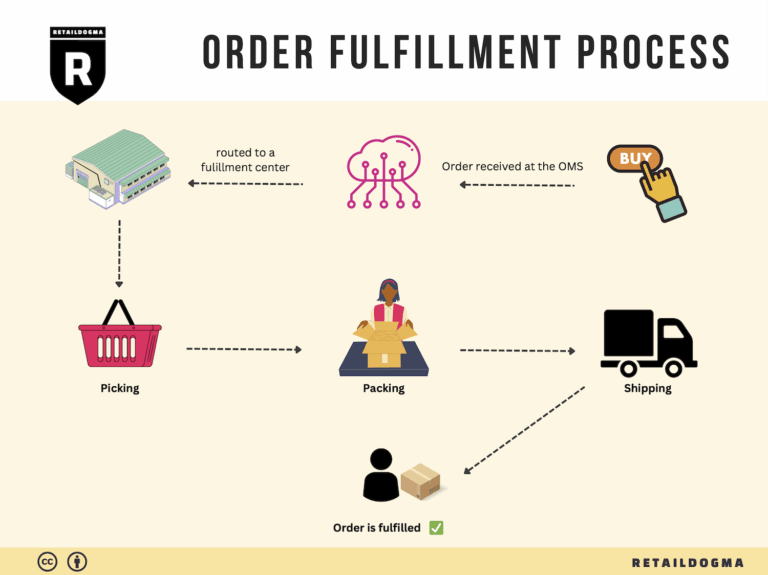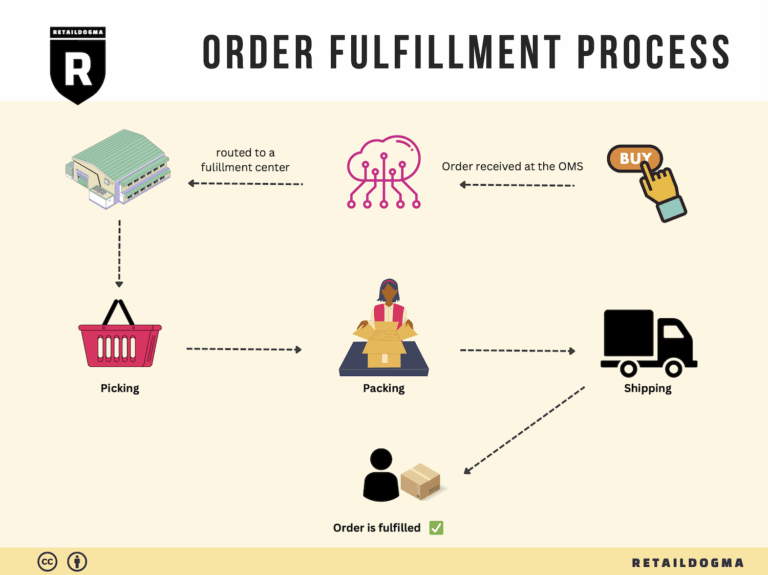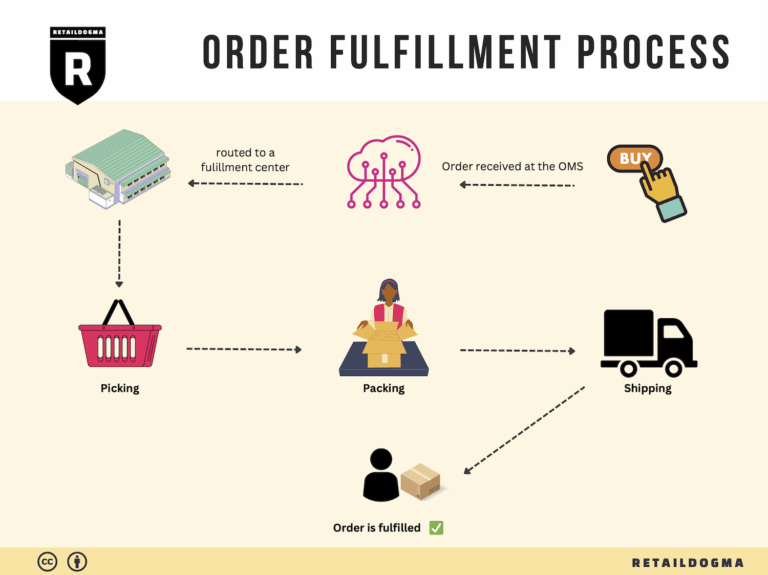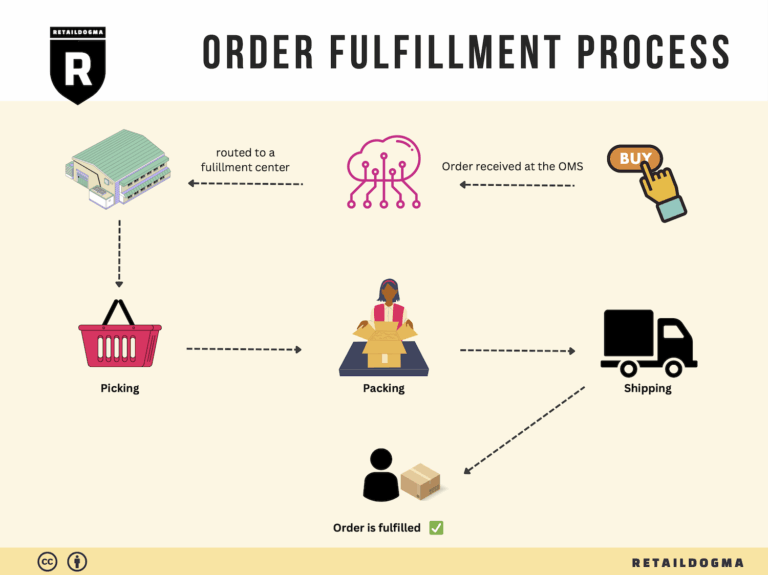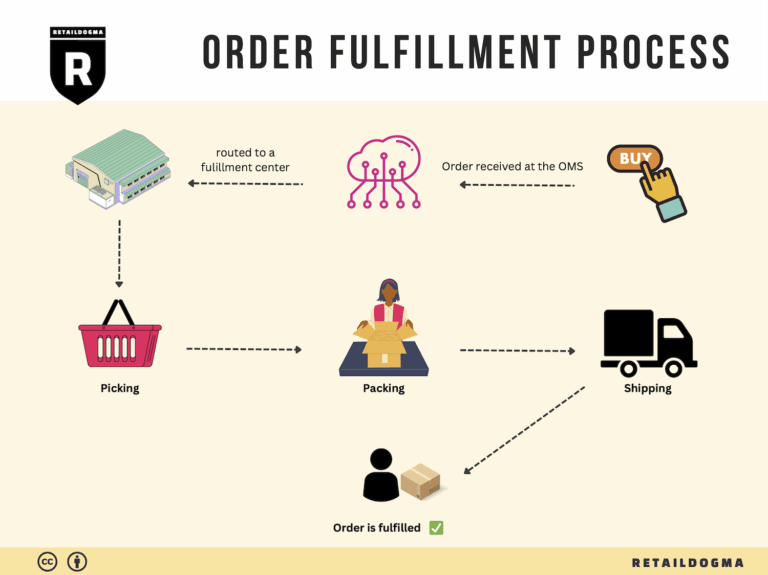Ecommerce Fulfillment Services: The Ultimate Guide (2025)
What is E-commerce Fulfillment? An Introduction for Growing Businesses
Managing an e-commerce business can be exhilarating, but it often comes with its own set of challenges. One of the most common pain points for growing online retailers is the overwhelming task of packing and shipping orders. As sales increase, so does the complexity of logistics, leading to potential delays, errors, and customer dissatisfaction. This is where understanding e-commerce fulfillment becomes crucial.
Fulfillment is simply the process of getting a product from your inventory to your customer’s doorstep. It encompasses everything from inventory management and order processing to packaging, shipping, and handling returns. For many entrepreneurs, the fulfillment process can quickly become a bottleneck that stifles growth. To effectively scale your business, you need a clear strategy for managing fulfillment efficiently and cost-effectively.
This guide will delve into various fulfillment models that can help streamline your operations. We will explore options such as Fulfillment by Amazon (FBA) and third-party logistics (3PL) providers, both of which offer unique advantages depending on your business needs. Each model has its own set of core services, including storage solutions, shipping logistics, and customer service support, which can significantly impact your operational efficiency.
Moreover, we will discuss how to choose the right fulfillment partner. Factors to consider include service offerings, technology integration, and pricing structures. Understanding these elements can help you make informed decisions that align with your business goals and customer expectations.
Finally, we will break down the pricing associated with different fulfillment options, including hidden fees and cost-saving strategies. Being aware of the financial implications of each model is essential for maintaining healthy profit margins as you scale.
The ultimate goal of this guide is to empower your business with the knowledge and tools necessary to make smart decisions about logistics. By understanding the intricacies of e-commerce fulfillment, you can enhance operational efficiency, improve customer satisfaction, and ultimately drive growth in your online business.
What You’ll Learn In This Guide
- What is E-commerce Fulfillment? An Introduction for Growing Businesses
- The Order Fulfillment Process: From ‘Buy’ Button to Customer’s Door
- Comparing Fulfillment Models: In-House vs. 3PL vs. Dropshipping
- A Deep Dive into Amazon FBA: Pros, Cons, and Who It’s For
- Core Services Offered by Fulfillment Centers
- How to Choose a Fulfillment Partner: A 6-Point Checklist
- Understanding Fulfillment Pricing: A Breakdown of Common Fees
- Frequently Asked Questions (FAQs) about Fulfillment
- Conclusion: Is Outsourcing Fulfillment the Right Move for Your Business?
- Important Disclaimer
The Order Fulfillment Process: From ‘Buy’ Button to Customer’s Door
1. Receiving Inventory
The order fulfillment process begins with receiving inventory at Amazon’s fulfillment centers. When you, as a seller, ship your products to Amazon, they arrive at designated warehouses where the Amazon team is responsible for checking them in. This process involves scanning the items against a shipping plan you created in Seller Central to ensure that everything matches up accurately.
Importance: This step is crucial because it establishes the initial inventory levels and ensures that products are accounted for in Amazon’s system. Accurate receiving prevents discrepancies that could lead to stockouts or overstock situations.
Key Term: SKU (Stock Keeping Unit) – This unique identifier is assigned to each product for tracking purposes. It helps in managing inventory efficiently and is essential during the receiving process to ensure that the right products are logged into the system.
2. Warehouse Storage
Once the inventory is checked in, it is stored in Amazon’s fulfillment centers. The organization of this storage is meticulously planned, leveraging a sophisticated algorithm that optimizes space based on product dimensions, weight, and sales velocity. Products are placed in locations that allow for quick access during the order fulfillment process.
Importance: Efficient warehouse storage minimizes the time taken to retrieve products when orders come in, which is vital for maintaining fast shipping times. By utilizing advanced storage strategies, Amazon can handle massive volumes of inventory while keeping operational costs low.
Key Term: ASIN (Amazon Standard Identification Number) – Each product is assigned an ASIN, which is used for cataloging items. This identifier facilitates easy tracking and retrieval of products during the picking phase.
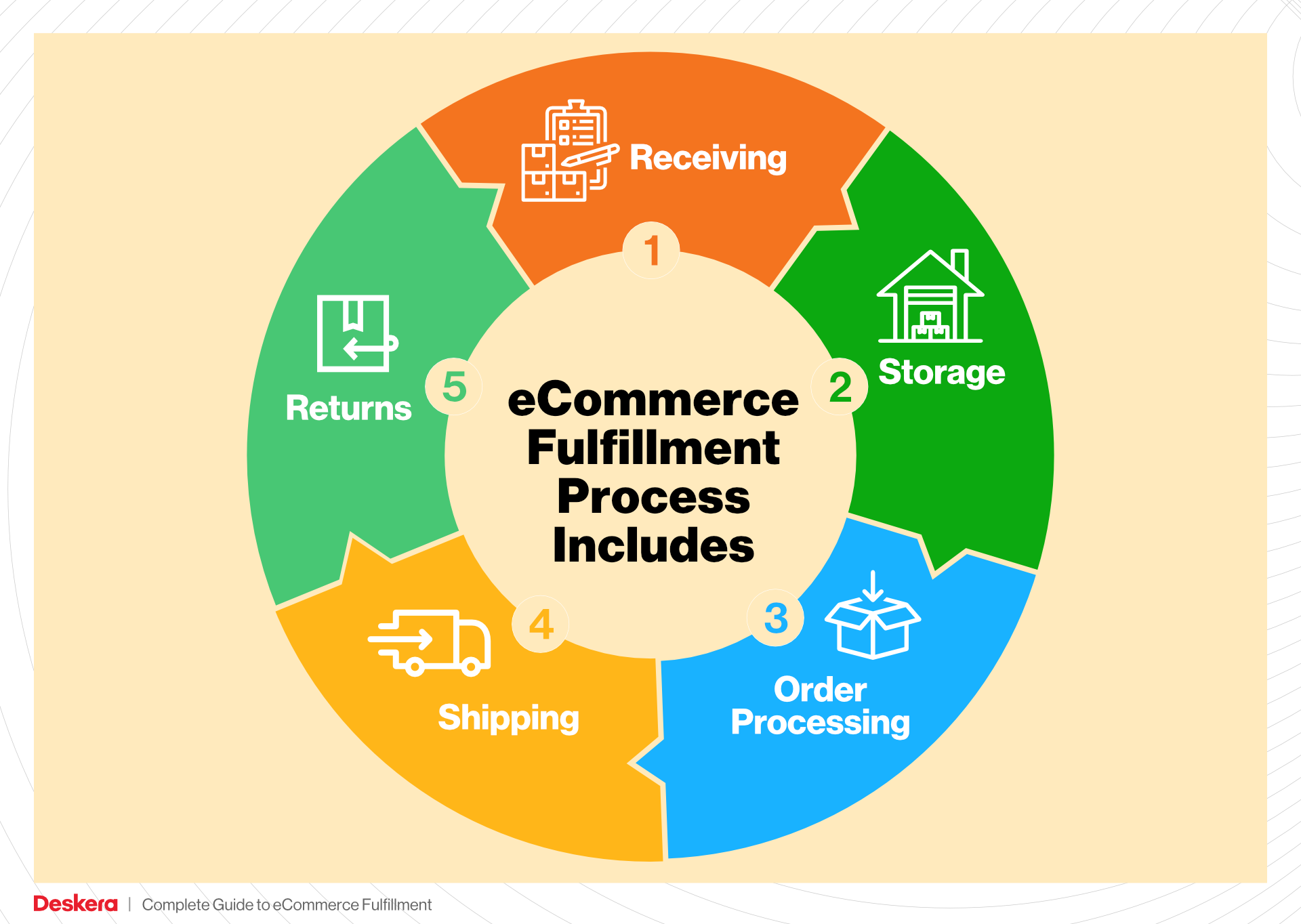
3. Order Picking
When a customer clicks the ‘Buy’ button, an order is generated, prompting the picking process. Amazon uses automated systems and human workers to retrieve the ordered items from their storage locations. This involves creating a pick list, which details the items and their respective locations within the warehouse.
Importance: The picking process is a critical step that directly impacts order accuracy and speed. An efficient picking operation ensures that products are gathered quickly and correctly, which is essential for maintaining customer satisfaction.
Key Term: Pick List – This document or digital list includes all items needed for an order, along with their storage locations. It streamlines the picking process, ensuring that warehouse staff can efficiently locate and collect products.
4. Order Packing
After the items are picked, they are sent to the packing station. Here, the products are carefully packed into boxes, ensuring they are secure for transit. Amazon employs various packaging materials, from standard boxes to custom-sized packaging, to minimize damage during shipping.
Importance: Proper packing is essential not only for protecting products but also for optimizing shipping costs. Well-packed items reduce the risk of returns due to damage, which can be costly for sellers.
Key Term: Packing Slip – This document is included with the shipment and contains details about the order. It serves as a confirmation of the items packed and provides essential information to the customer, enhancing the overall shopping experience.

5. Shipping & Delivery
The final step in the order fulfillment process is shipping the packed orders to customers. Once the packages are ready, they are handed over to Amazon’s logistics network or partnered carriers. Amazon offers various shipping options, including same-day and two-day delivery for Prime members, which significantly enhances the customer experience.
Importance: Timely delivery is a key factor in customer satisfaction and repeat business. Efficient shipping processes ensure that customers receive their orders quickly, reinforcing their trust in the Amazon platform.
Key Term: Last-Mile Delivery – This term refers to the final step in the shipping process, where the package is delivered from a distribution center to the customer’s doorstep. This stage is often the most critical in determining customer satisfaction and is a focal point for improving logistics efficiency.
In conclusion, understanding each step in the order fulfillment process is essential for e-commerce business owners and operations managers. By optimizing these steps, you can enhance operational efficiency, reduce costs, and ultimately improve customer satisfaction, which is vital for scaling your business in the competitive landscape of e-commerce.
Comparing Fulfillment Models: In-House vs. 3PL vs. Dropshipping
Fulfillment Models Comparison
| Model | Who Handles Inventory | Best For (Business Stage) | Key Advantage | Key Disadvantage |
|---|---|---|---|---|
| In-House Fulfillment | Business Owner | Startups to Established | Complete control over operations | High overhead costs and time-consuming |
| Third-Party Logistics (3PL) | 3PL Provider | Scaling Businesses | Scalability and flexibility | Less control over inventory and processes |
| Dropshipping | Supplier | New Entrepreneurs and Small Scale | Low upfront investment | Lower profit margins and potential delays |
In-House Fulfillment
In-house fulfillment involves managing your own inventory and shipping processes. This model is often favored by startups and established businesses that have the resources to handle logistics in-house. The key advantage of in-house fulfillment is the complete control it offers over operations, including inventory management, shipping, and customer service. Businesses can customize their packaging and handling processes to align with their branding and customer expectations. However, this model also comes with significant disadvantages, such as high overhead costs associated with warehousing, staffing, and operational management. Additionally, it can be time-consuming, as business owners must handle logistics alongside other critical business functions. As a business scales, maintaining efficiency while managing increased order volume can become challenging, leading to potential bottlenecks.
Third-Party Logistics (3PL)
Third-party logistics (3PL) providers are specialized firms that handle logistics and fulfillment on behalf of e-commerce businesses. This model is particularly beneficial for companies looking to scale operations without the burden of managing their own warehouses and logistics. A key advantage of 3PL is scalability; businesses can quickly adjust their logistics needs based on demand without significant investment in infrastructure. Moreover, 3PL providers typically have established networks that can reduce shipping costs and improve delivery times. However, one of the main drawbacks is the loss of control over inventory and logistics processes. Businesses must rely on their 3PL partners to manage inventory accuracy, shipping, and customer service, which can lead to issues if the provider does not meet expectations. Additionally, integrating a 3PL into existing systems can sometimes pose challenges in terms of technology and communication.
Dropshipping
Dropshipping is a fulfillment model where the retailer does not keep products in stock but instead transfers customer orders directly to a supplier, who then ships the products directly to the customer. This model is particularly attractive for new entrepreneurs and those operating on a small scale, as it requires a low upfront investment and minimal financial risk. The key advantage of dropshipping is that business owners do not need to manage inventory, storage, or shipping, allowing them to focus on marketing and sales. However, dropshipping also comes with its share of challenges. Profit margins can be lower compared to other fulfillment methods since suppliers often charge higher prices for the convenience of dropshipping. Additionally, businesses face potential delays in shipping and inventory management issues, as they have limited control over the supplier’s operations. Customer satisfaction can also be impacted by the reliability of the dropshipper, making it crucial to partner with reputable suppliers.
Conclusion
When deciding on a fulfillment model, e-commerce business owners must carefully consider their unique needs, resources, and long-term goals. Each model has its strengths and weaknesses, making it essential to align the choice with the specific stage of the business. In-house fulfillment offers control but demands significant resources, while 3PL provides scalability at the cost of some oversight. Dropshipping minimizes risk but can lead to challenges in profit margins and customer satisfaction. Understanding these nuances will enable business owners to make informed decisions that support their growth and operational efficiency.
A Deep Dive into Amazon FBA: Pros, Cons, and Who It’s For
Understanding Fulfillment by Amazon (FBA)
Fulfillment by Amazon (FBA) is a service that allows sellers to leverage Amazon’s extensive logistics network to store, package, and ship their products. Essentially, when you choose FBA, you send your inventory to Amazon’s fulfillment centers, and Amazon takes care of the rest. This includes picking, packing, shipping, customer service, and returns management. FBA can significantly streamline operations for e-commerce businesses, especially for those looking to scale quickly without the complexities of managing logistics.
How FBA Works
-
Inventory Storage: Sellers send their products to Amazon fulfillment centers. Once received, the products are stored until sold.
-
Order Fulfillment: When a customer places an order, Amazon handles all aspects of the fulfillment process. This includes picking the product from the inventory, packing it, and shipping it to the customer.
-
Customer Service: Amazon manages customer service and returns for FBA orders. This means that if a customer has an issue or wants to return a product, they will contact Amazon, which alleviates the seller from these responsibilities.
-
Multi-Channel Fulfillment: Sellers can also use FBA to fulfill orders from other sales channels, not just Amazon. This means that if you have an e-commerce store outside of Amazon, you can still leverage FBA to manage your logistics.
Pros of Using FBA
Prime Eligibility
One of the most significant advantages of using FBA is that it automatically qualifies your products for Amazon Prime. This means that your products will be eligible for free two-day shipping for Prime members, which can dramatically increase sales. Prime members tend to buy more frequently and are less price-sensitive, primarily due to the benefits of quick shipping.
Customer Trust
Amazon has built a reputation for reliability and customer service. When customers see that a product is fulfilled by Amazon, they are more likely to trust the seller, leading to higher conversion rates. The Amazon brand itself conveys quality assurance, which can enhance your product’s perceived value.
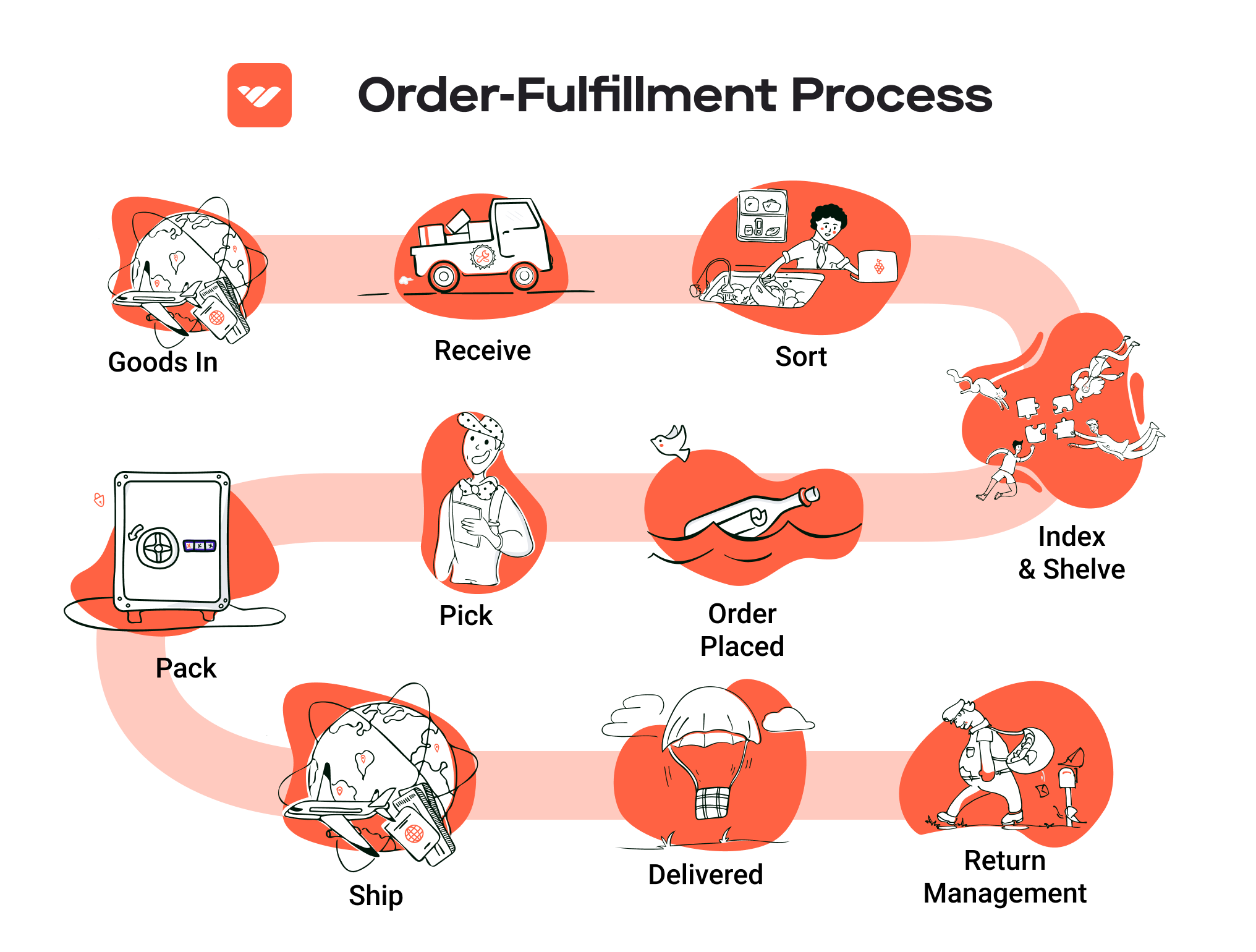
Multi-Channel Fulfillment
FBA isn’t limited to just Amazon sales. Sellers can utilize FBA for orders from other platforms, such as their own websites or eBay. This flexibility allows businesses to centralize their inventory and streamline operations, making it easier to manage logistics across multiple sales channels.
Cons of Using FBA
High Fees
While FBA offers numerous benefits, it comes at a cost. The fees associated with FBA can be substantial, often ranging from 30% to 40% of the product price when considering storage and fulfillment fees. Sellers must carefully calculate these fees to ensure profitability, as they can significantly eat into margins.
Strict Inventory Rules
Amazon imposes strict inventory management policies, including limits on how much inventory you can send based on your sales history and Inventory Performance Index (IPI) score. This can be particularly challenging for businesses that experience rapid fluctuations in demand, as they may find themselves unable to scale their inventory accordingly.
Commingling Risks
When using FBA, your inventory may be commingled with that of other sellers. This means that if a customer receives a damaged or defective product, it can be difficult to trace it back to the original seller, which can lead to negative reviews and customer dissatisfaction. Sellers must weigh the risks of commingling against the convenience of using FBA.
Who is FBA Best For?
FBA can be an excellent choice for a variety of sellers, but it is particularly well-suited for:
-
Small to Medium-Sized Businesses: Companies without the resources to manage their own warehousing and logistics can benefit significantly from the operational efficiency of FBA.
-
E-commerce Entrepreneurs: New sellers or those with limited experience in logistics can leverage FBA to quickly establish a presence on Amazon without needing extensive knowledge of fulfillment processes.
-
Businesses with High Sales Volume: If you have products that sell quickly, FBA can help you scale effectively by ensuring that orders are fulfilled promptly and efficiently.
-
Sellers of Lightweight and Small Products: Since FBA fees are often based on size and weight, sellers with smaller, lighter products are likely to find FBA more cost-effective.
Conversely, FBA may not be the best fit for:
-
Large and Heavy Products: Sellers offering bulky or heavy items may find the FBA fees prohibitive, making fulfillment via other methods more financially viable.
-
Businesses with Established Fulfillment Systems: Companies that already have their own warehousing and logistics capabilities may prefer to maintain control over their fulfillment processes rather than relying on Amazon.
-
Sellers Seeking High Control: If you want to have complete control over shipping, packaging, and returns, FBA may not align with your business model.
In conclusion, Fulfillment by Amazon offers a powerful solution for e-commerce businesses looking to streamline operations and scale quickly. However, it’s essential to weigh the pros and cons carefully and consider your specific business needs before deciding if FBA is the right choice for you.
Core Services Offered by Fulfillment Centers
Inventory Management & Warehousing
Inventory management and warehousing form the backbone of any fulfillment center’s operations. This service involves the systematic tracking and storage of products in a warehouse, ensuring that stock levels are maintained to meet customer demand without overstocking. Fulfillment centers utilize sophisticated inventory management systems that provide real-time data on stock availability, allowing e-commerce businesses to make informed decisions regarding purchasing, sales forecasting, and inventory replenishment.
Benefits:
1. Efficiency: By outsourcing inventory management, e-commerce businesses can focus on core activities like marketing and product development rather than worrying about stock levels and storage logistics.
2. Cost-Effectiveness: Fulfillment centers offer scalable warehousing solutions, which can be particularly beneficial for businesses experiencing seasonal fluctuations in demand. This flexibility helps mitigate the costs associated with maintaining a large warehouse.
3. Reduced Risk of Stockouts: With accurate inventory tracking, fulfillment centers can alert businesses when stock levels are low, minimizing the risk of stockouts that can lead to lost sales and dissatisfied customers.
4. Centralized Storage: Having a centralized location for inventory helps streamline shipping processes and reduces shipping times, which is crucial for maintaining customer satisfaction in today’s fast-paced e-commerce environment.
Pick and Pack Services
Pick and pack services refer to the process of selecting items from inventory (picking) and packaging them for shipment (packing). Fulfillment centers employ trained staff and advanced technology to efficiently pick items according to customer orders, ensuring accuracy and speed in the fulfillment process.
Benefits:
1. Speed: Fulfillment centers are designed for rapid order processing. This efficiency translates to faster delivery times, which is a key differentiator in the competitive e-commerce landscape.
2. Accuracy: With automated systems and trained personnel, the likelihood of order errors is significantly reduced. Accurate order fulfillment enhances customer satisfaction and trust, which can lead to repeat purchases.
3. Customization: Many fulfillment centers offer customized packing options, allowing e-commerce businesses to create unique unboxing experiences that can enhance brand loyalty.
4. Scalability: As order volumes fluctuate, fulfillment centers can easily scale their pick and pack operations to meet increasing or decreasing demands without the need for businesses to hire or train additional staff.
Kitting and Assembly
Kitting and assembly services involve combining multiple products into a single package or assembling products before shipment. This service is particularly beneficial for e-commerce businesses that sell items that require assembly or bundling, such as gift sets or promotional packages.
Benefits:
1. Enhanced Product Offerings: Kitting allows businesses to create unique product bundles that can attract customers and encourage higher sales volumes. This approach not only increases average order value but also enhances customer satisfaction by providing convenience.
2. Reduced Labor Costs: By outsourcing kitting and assembly to fulfillment centers, businesses can reduce labor costs associated with in-house assembly, allowing them to allocate resources more effectively.
3. Streamlined Operations: Fulfillment centers have the necessary tools and expertise to efficiently assemble products, which can help reduce lead times and improve overall operational efficiency.
4. Inventory Control: By managing kitting at the fulfillment center, businesses can maintain better control over inventory levels, ensuring that all components are available when needed and reducing the risk of stockouts.
Returns Management (Reverse Logistics)
Returns management, or reverse logistics, is the process of handling returned products, including inspection, restocking, and managing refunds or exchanges. Fulfillment centers play a critical role in this process by streamlining returns to minimize costs and maximize recovery from returned items.
Benefits:
1. Improved Customer Experience: Efficient returns management is essential for maintaining customer satisfaction. Fulfillment centers can quickly process returns, allowing customers to receive refunds or exchanges in a timely manner, which fosters trust and encourages repeat business.
2. Cost Reduction: By outsourcing returns management, e-commerce businesses can save on operational costs associated with handling returns in-house. Fulfillment centers often have established processes that minimize the costs associated with reverse logistics.
3. Data Insights: Fulfillment centers can provide valuable data on return rates, reasons for returns, and product performance. This information can help businesses make informed decisions regarding product quality, inventory management, and customer service improvements.
4. Restocking Efficiency: Fulfillment centers can quickly assess returned items and determine whether they can be restocked, repaired, or need to be disposed of, ensuring that inventory levels remain accurate and that lost revenue is minimized.
In summary, fulfillment centers provide a range of core services that are vital for e-commerce businesses looking to scale their operations efficiently. By leveraging these services, businesses can enhance their operational capabilities, improve customer satisfaction, and ultimately drive growth in a competitive marketplace.
How to Choose a Fulfillment Partner: A 6-Point Checklist
Location & Warehouse Network
Importance:
The geographic location of your fulfillment partner’s warehouses is crucial for minimizing shipping times and costs. A strategically placed warehouse network can significantly enhance your delivery speed, especially if you cater to a wide geographical area or have a large customer base.
Questions to Ask:
– Where are your fulfillment centers located, and how does that align with my customer base?
– Can you provide coverage across multiple regions, including international locations if necessary?
– What is your average shipping time to various regions from your warehouses?
Technology & Integrations
Importance:
In today’s digital age, the technology used by your fulfillment partner can streamline operations, enhance accuracy, and improve customer experience. Integration capabilities with your existing e-commerce platforms are also essential for real-time inventory tracking and order management.
Questions to Ask:
– What warehouse management system (WMS) do you use, and how does it integrate with popular e-commerce platforms?
– Can you provide real-time tracking and reporting tools for inventory and order status?
– How do you handle system updates, and what level of technical support do you offer?
Specializations (e.g., Cold Storage, Oversized Items)
Importance:
Different businesses have different requirements. If your products require special handling—such as perishables needing cold storage or oversized items needing special packaging—it’s vital to partner with a fulfillment provider that specializes in those areas.
Questions to Ask:
– Do you have facilities that accommodate special storage needs (e.g., temperature-controlled environments)?
– What experience do you have in handling my specific product types?
– Are there any additional fees associated with specialized storage or handling?
Scalability & Capacity
Importance:
As your business grows, your fulfillment needs may change. A partner that can scale with your business ensures that you won’t have to switch providers as your order volume increases, which can lead to disruptions in service.
Questions to Ask:
– What is your current capacity, and how quickly can you scale up operations if my order volume increases?
– How do you manage seasonal fluctuations in demand?
– Are there any limitations on the types or quantities of products you can handle?
Pricing and Contracts
Importance:
Understanding the pricing structure and contract terms is vital for budgeting and financial forecasting. Transparent pricing helps prevent unexpected fees that can erode your profit margins.
Questions to Ask:
– What is included in your pricing model? Are there additional fees for services such as storage, pick and pack, or returns?
– Can you provide a breakdown of your pricing for different services?
– What are the terms of the contract? Are there any penalties for early termination or changes in service?
Customer Support & Reviews
Importance:
Effective customer support can make a significant difference in resolving issues quickly and maintaining a smooth operation. Partnering with a fulfillment provider that has a solid reputation for customer service can enhance your business’s reliability.
Questions to Ask:
– What levels of customer support do you offer? Is it available 24/7?
– How do you handle customer service inquiries and issues related to fulfillment?
– Can you provide references or case studies from current clients to assess your service quality?
Conclusion
Choosing the right fulfillment partner is a critical decision that can greatly influence your e-commerce business’s success. By using this checklist and asking the right questions, you can make an informed decision that aligns with your operational goals and customer expectations. Remember to assess not just the immediate needs of your business, but also how a potential partner can support your growth in the long term.
Understanding Fulfillment Pricing: A Breakdown of Common Fees
Initial Setup Fees
When you begin using Fulfillment by Amazon (FBA), there may be initial setup fees that cover the costs associated with creating your seller account and setting up your product listings. These fees can vary depending on whether you opt for an Individual or Professional seller account.
- Individual Seller Account: No monthly subscription fee, but you pay a per-item fee for each sale.
- Professional Seller Account: A fixed monthly fee (approximately $39.99) regardless of how many items you sell, which can be more cost-effective for sellers with higher sales volumes.
It’s essential to evaluate your expected sales volume to determine which account type will be more economical in the long run.
Receiving Fees
Once your products arrive at Amazon’s fulfillment centers, receiving fees apply. These fees are charged per unit and cover the cost of Amazon’s staff unpacking, inspecting, and storing your items.
- Calculation: The receiving fee is typically a small fixed amount per item, which can vary based on the size and weight of the products. For instance, standard-size items may incur lower fees compared to oversized items.
Understanding these fees upfront allows sellers to factor them into their pricing strategy.
Storage Fees (per pallet/bin)
Storage fees are charged monthly based on the volume of space your inventory occupies in Amazon’s warehouses. These fees can be categorized into two types:
-
Monthly Storage Fees: Charged monthly based on the average daily volume of your inventory in cubic feet. These fees tend to be lower from January to September and increase during the holiday season (October to December).
-
Long-Term Storage Fees: Applied to items that have been in Amazon’s fulfillment centers for more than 365 days. This fee is significantly higher and is charged per cubic foot, encouraging sellers to manage their inventory effectively.
-
Calculation: To calculate your potential storage fees, monitor your inventory turnover rate and ensure that you are not holding onto products longer than necessary to avoid incurring long-term storage charges.
Pick & Pack Fees (per item/order)
Pick and pack fees are charged for the services of picking your items from the shelves and packing them for shipment to customers. These fees are typically assessed on a per-item basis and can vary based on the size of the item.
- Calculation: For standard-size items, the fee is generally lower compared to oversized items, which incur higher pick and pack fees. The fees can be structured as a base fee plus an additional amount for each item in a multi-item order, meaning that larger orders could lead to increased costs.
Understanding these fees can help you optimize your product listings and inventory management.
Shipping Fees
Shipping fees cover the cost of transporting your products from Amazon’s fulfillment centers to the customer. These fees are influenced by various factors, including the size, weight, and delivery speed of the items.
- Calculation: Amazon uses a tiered pricing structure based on the size and weight of the item. Standard-size items typically incur lower shipping fees than oversized items. Additionally, shipping fees can vary depending on whether the product is shipped within the same region or across states.
For sellers using FBA, these costs are automatically calculated and deducted from the sale price, so it’s crucial to account for them in your pricing strategy.
Tips for Getting an Accurate Quote
-
Use Amazon’s FBA Calculator: Leverage Amazon’s FBA Calculator to estimate fees based on your specific product details. This tool can provide insights into potential profitability after accounting for all fees.
-
Monitor Inventory Levels: Regularly check your inventory levels to avoid long-term storage fees and ensure you are not overstocking items.
-
Evaluate Product Size and Weight: Be mindful of how the size and weight of your products impact storage and shipping fees. Consider sourcing smaller, lighter products to minimize costs.
-
Stay Updated on Fee Changes: Amazon periodically updates its fee structure. Stay informed about any changes to ensure you’re accurately calculating your costs.
By understanding these common fulfillment pricing models and how they are calculated, e-commerce businesses can make informed decisions about using FBA and ultimately enhance their operational efficiency and profitability.
Frequently Asked Questions (FAQs) about Fulfillment
1. What is Fulfillment by Amazon (FBA)?
Fulfillment by Amazon (FBA) is a service that allows sellers to store their products in Amazon’s fulfillment centers. Amazon takes care of storage, packaging, shipping, customer service, and returns. This enables sellers to leverage Amazon’s logistics network and customer trust, making it easier to scale their e-commerce businesses.
2. What are the benefits of using FBA?
The main benefits of FBA include access to Amazon Prime customers, fast shipping options, streamlined customer service and returns management, and reduced operational burdens on sellers. Additionally, FBA allows sellers to tap into Amazon’s vast logistics capabilities, which can enhance customer satisfaction and boost sales.
3. What are the costs associated with FBA?
FBA costs include referral fees (typically around 15% of the sale price), fulfillment fees based on the size and weight of the product, and monthly storage fees for items stored in Amazon’s fulfillment centers. It’s essential to calculate these fees before deciding on FBA to ensure profitability.
4. How does FBA handle returns?
When a customer returns an item fulfilled by FBA, Amazon manages the entire return process. If the item is in sellable condition, Amazon will restock it in the seller’s inventory. This automated handling of returns can save sellers time and effort compared to managing returns themselves.
5. What’s the difference between a warehouse and a fulfillment center?
A warehouse is primarily a storage facility where goods are kept until needed, while a fulfillment center is a specialized facility designed for processing and fulfilling customer orders. Fulfillment centers focus on picking, packing, and shipping products directly to customers, often with additional services like returns management and inventory tracking.
6. Can I use FBA to fulfill orders from my own website or other marketplaces?
Yes, Amazon FBA offers a service called Multi-Channel Fulfillment (MCF), allowing sellers to use FBA to fulfill orders from their own e-commerce sites or other marketplaces. This means you can leverage Amazon’s logistics for orders not placed on Amazon.com, expanding your sales potential.
7. What is a 3PL, and how does it compare to FBA?
A Third-Party Logistics provider (3PL) offers a range of logistics services, including warehousing, fulfillment, shipping, and inventory management. Unlike FBA, which is specifically tied to Amazon’s platform, a 3PL can cater to multiple sales channels and provide more customized logistics solutions. Choosing between FBA and a 3PL depends on your business model and operational needs.
8. Are there any inventory limits with FBA?
Yes, Amazon has implemented inventory limits based on a seller’s sales history and Inventory Performance Index (IPI) score. This means that sellers may be restricted on the amount of inventory they can send to fulfillment centers, which is designed to prevent overstocking and ensure efficient inventory management.
9. How do I get started with FBA?
To start using FBA, you’ll need to create an Amazon seller account, set up a shipping plan through Seller Central, package your products according to Amazon’s requirements, and send your inventory to an Amazon fulfillment center. Once your products are received, they will become eligible for Prime shipping.
10. Is FBA right for my business?
FBA may be right for your business if you sell small, lightweight products, lack storage space, want to offer Prime shipping, or prefer to outsource customer service and returns. Conversely, if you sell large or heavy items, want to control shipping processes, or have your own fulfillment capabilities, you might consider alternatives such as Fulfilled by Merchant (FBM) or using a 3PL.
Conclusion: Is Outsourcing Fulfillment the Right Move for Your Business?
Evaluating the Benefits of Outsourcing Fulfillment
Outsourcing your fulfillment process can be a transformative decision for your e-commerce business. One of the most significant advantages is time savings. By leveraging a fulfillment service, you free up valuable resources that can be redirected towards strategic initiatives such as marketing, product development, and customer engagement. This shift not only enhances operational efficiency but also allows you to focus on scaling your business rather than getting bogged down in logistics.
Scalability is another critical benefit. As your business grows, so do the complexities of managing inventory, shipping, and returns. A reliable fulfillment partner can adapt to your changing needs, ensuring that you can meet increased demand without compromising on service quality. This adaptability is essential in today’s fast-paced e-commerce environment where consumer expectations for speed and reliability are higher than ever.
Additionally, outsourcing fulfillment means tapping into specialized expertise. Fulfillment service providers bring established systems and technologies that can streamline your operations and improve accuracy. Their experience can help you navigate challenges such as peak season demands, inventory management, and international shipping, which might be daunting for smaller businesses.
However, the choice of a fulfillment partner is crucial for your growth trajectory. It’s essential to conduct thorough research and select a provider that aligns with your business goals, offers transparent pricing, and can deliver the level of service your customers expect.
Take Action
To determine if outsourcing fulfillment is the right step for your business, start by auditing your current shipping processes. Evaluate your costs, efficiency, and customer satisfaction levels. This assessment will provide valuable insights into whether a fulfillment partner could enhance your operational capabilities and support your growth objectives. The right partnership can pave the way for a more streamlined, scalable, and successful e-commerce operation.
Important Disclaimer
⚠️ Important Disclaimer
The information in this guide is for educational purposes. Fulfillment services, pricing, and platform features change frequently. Always conduct your own due diligence and consult with providers directly before making business decisions.

